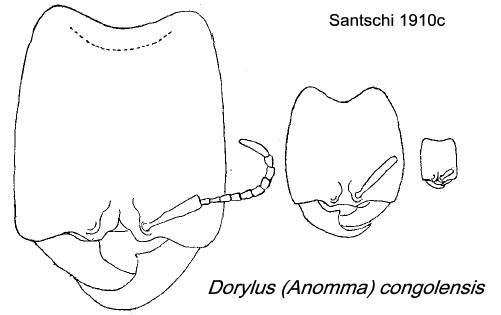Dorylus (Anomma) congolensis Santschi
  Type locality Congo (Dorylus
(Anomma) Kohli Wasm. var. congolensis, nov., Santschi,
1910c: 352,
illustrated, workers, collected at Brazzaville, by Weiss, ; also
Santschi, 1912b; raised to species by Boven & Lévieux, 1970: 376);
soldier only known (see Bolton (1995) Type locality Congo (Dorylus
(Anomma) Kohli Wasm. var. congolensis, nov., Santschi,
1910c: 352,
illustrated, workers, collected at Brazzaville, by Weiss, ; also
Santschi, 1912b; raised to species by Boven & Lévieux, 1970: 376);
soldier only known (see Bolton (1995)
junior synonym minor
- Raignier & van Boven
considered minor (Dorylus
(Anomma) Kohli Wasm. v. minor
n. var., Santschi, 1911g: 206) from Angola as
having no significant differences to the media worker, TL ca 8, of congolensis,
therefore, it is included here as a junior synonym  . .
|
 Santschi's (1910c) description is at Santschi's (1910c) description is at  and and  (the comparison was with D. kohli).
Santschi's (1911g) description of minor is at (the comparison was with D. kohli).
Santschi's (1911g) description of minor is at 
Described by Wheeler as "head of workers measuring (TL)
7 mm is as broad as long, whereas in the typical kohli it is
longer than broad, with somewhat less pointed posterior angles".
Also from Congo at N'Douna, A. Weiss; and Zaïre,
at Leopoldville, under a piece of tin on the shore of Stanley Pool by
Lang & Chapin, and Thysville, by J. Bequaert, "marching in a
subterranean burrow in a forest gallery" (Wheeler, 1922, under kohli).
|
  Raignier & van Boven (1955) noting that Santschi's
description (1910c) was very detailed, gave the key characteristics.
Apparently, at the time the major of kohli was unknown so
Santschi compared his new variety with emeryi and
gerstaeckeri. Head matt and more sculptured than emeryi,
with an irregular shiny triangle on the vertex; scape and funiculus
segments shorter; petiole wider than long; differed from kohli
type by posterior of head being narrower, shorter and laterally more
convex, head square (HW = HL in 7 mm workers) whereas kohli is
longer than wide. Also they felt a key separation from congolensis
is the mandible in kohli being longer relative to the head
length, index > 160 ; ca 150 in congolensis. Raignier & van Boven (1955) noting that Santschi's
description (1910c) was very detailed, gave the key characteristics.
Apparently, at the time the major of kohli was unknown so
Santschi compared his new variety with emeryi and
gerstaeckeri. Head matt and more sculptured than emeryi,
with an irregular shiny triangle on the vertex; scape and funiculus
segments shorter; petiole wider than long; differed from kohli
type by posterior of head being narrower, shorter and laterally more
convex, head square (HW = HL in 7 mm workers) whereas kohli is
longer than wide. Also they felt a key separation from congolensis
is the mandible in kohli being longer relative to the head
length, index > 160 ; ca 150 in congolensis.
In their field studies in the essentially shady forest
area of Yangambi, Raignier & van Boven made 14 collections of congolensis,
a figure bettered only by the most common wilverthi. There was
a consistency of form and shape and their notes show -
TL 11-2.1, CI 91; head with posterior strongly
scalloped; mandibles short and quite straight, variably with subapical
tooth and denticles; funiculus segments 1-5 differing little in length
petiole wider than long; major head blackish red-brown (darker than kohli)
and spiculate with a shiny frontal area on some specimens, cheeks
darker, some specimens from shaded forest clear brown; mandibles and
gaster shiny. Smaller morphs (TL 5 mm) with shinier head, anterior
finely punctate, posterior shiny.
|
Oxford University Museum
specimens
Dorylus (Anomma) congolensis
B Taylor det.
|
Gabon
Y Braet
Gabon 08
|
27.v.2006
Pongara
00°34' N
09°19' E
|
Winkler termitiere
minima
|
1
|
|
Dorylus (Anomma) congolensis
B Taylor det. |
Gabon
Y Braet
Gabon 09 |
13.viii.2006
Pongara
00°34' N
09°19' E
|
Pointe Wingombe;
edge of path
|
3
|
 |
Dorylus (Anomma) congolensis
B Taylor det. |
Gabon
Y Braet
Gabon 10 |
20.vi.2006
Pongara
00°34' N
09°19' E
|
Pointe Wingombe; on
forest road
|
2
|
 |
Dorylus (Anomma) congolensis
B Taylor det. |
Central African
Republic
P Annoyer
NX
|
25.xi.2010
Dzanga-Sangha
2°28'53.6"N
16°13'38.4"E
|
392 m; jour, à vue,
lac 2 - lac 2bis
media & minima workers
|
5
|
 |
|
 Polymorphism Polymorphism
The photomontage of type form cotypes is collated from
The Smithsonian Institute images at http://ripley.si.edu/ent/nmnhtypedb/public/specimeninfopage.cfm?publicconsumption=1&typespecimenID=964.
The various morphs are shown in detail on the Dorylus (Dorylus) congolensis
morphs page. Also shown are specimens of minor from Angola.
Modern specimens from the Gabon and Central African Republic
in detail on the Dorylus (Dorylus)
congolensis OUM page.
See also the type images at http://www.antweb.org/images.do?species=congolensis&genus=dorylus&rank=species&project=allantwebants
also with minor at http://www.antweb.org/specimenImages.do?code=casent0911300 at http://www.antweb.org//images.do?subfamily=dorylinae&genus=dorylus&species=kohli&subspecies=minor&rank=subspecies&project=allantwebants
|
|